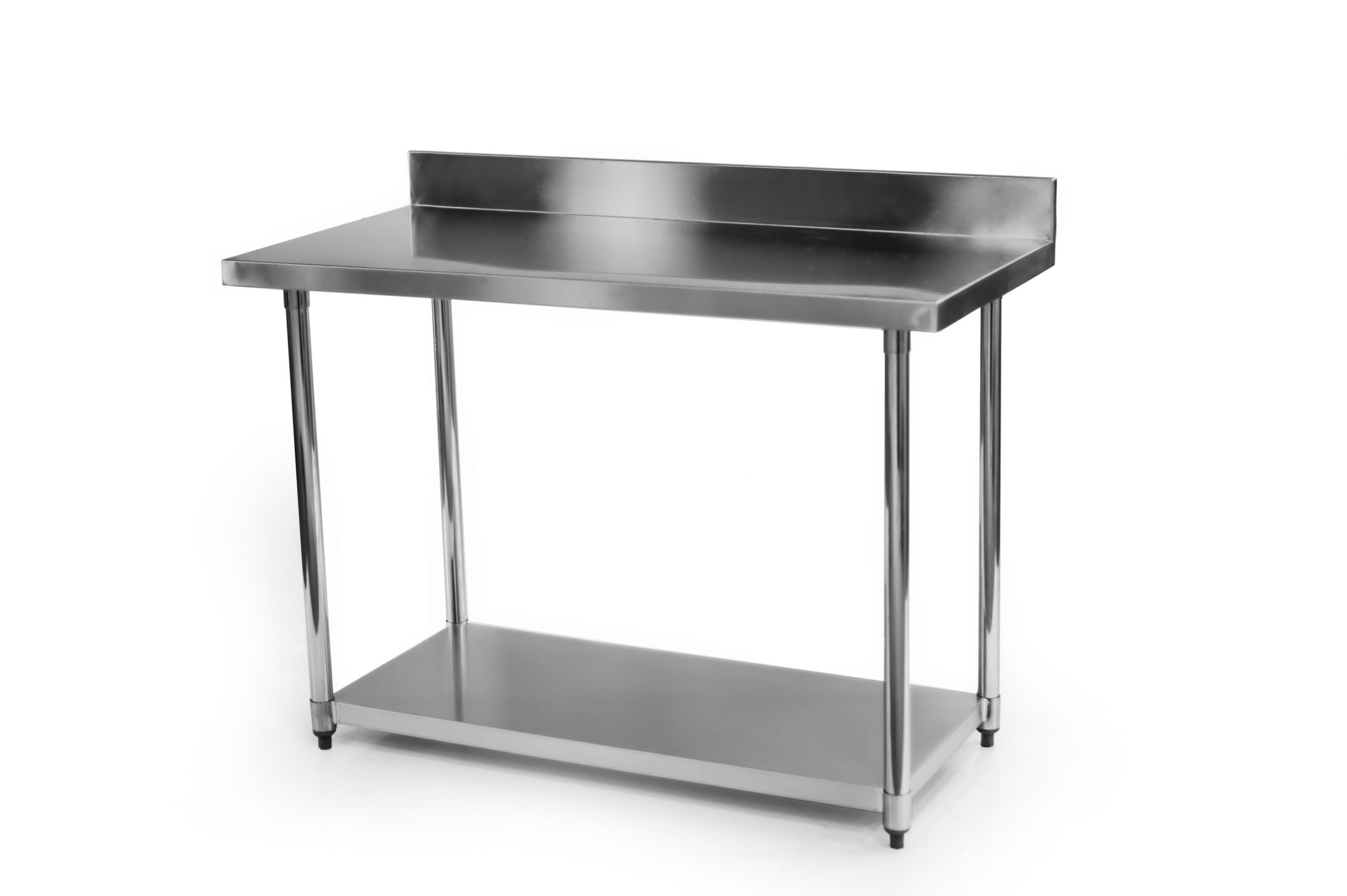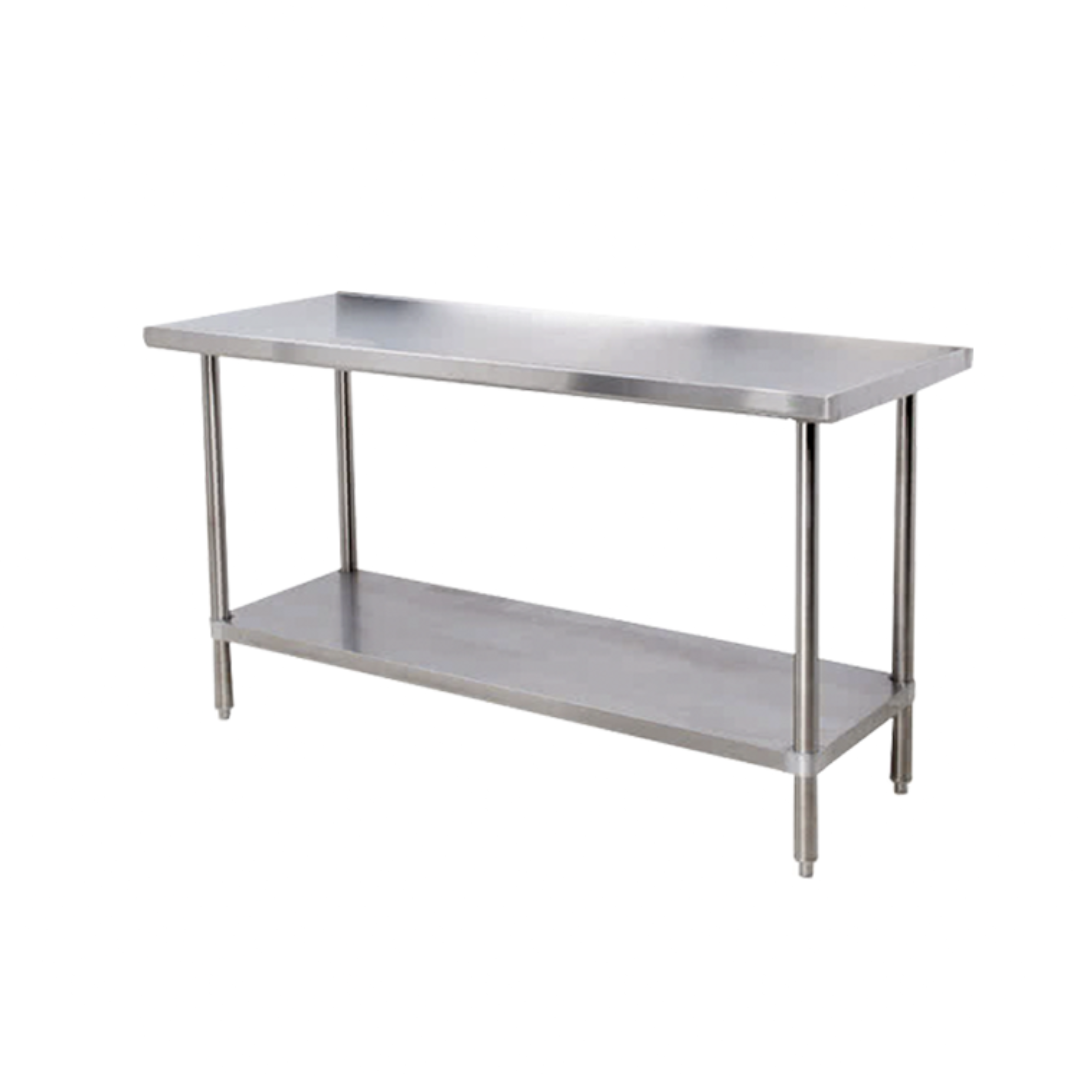How a Stainless Steel Table Elevates Your Culinary Workspace
Wiki Article
The Crucial Duty of a Stainless-steel Table in Producing an Effective Kitchen
In modern kitchens, the stainless-steel table offers as a keystone for performance. Its resilience and hygienic homes make it suitable for various cooking jobs. This flexible surface area boosts operations by advertising company and maximizing room. As kitchen areas progress, the function of stainless-steel remains to adapt, blending capability with appearances - Stainless Steel Table. Understanding its effect exposes much more about how it changes cooking atmospheres and sustains culinary creativity
Longevity and Longevity: Why Stainless Steel Tables Stand the Examination of Time
Stainless steel tables are renowned for their amazing durability and durability. Constructed from top notch products, they withstand rust, discoloration, and corrosion, making them excellent for the demanding atmosphere of a cooking area. Unlike wood or plastic, stainless steel does not warp or split, making sure a stable surface area for food preparation and other tasks.These tables can stand up to extreme temperature levels, from hot pots to cold ingredients, without endangering architectural honesty. Their non-porous surface area prevents germs and other contaminants from passing through, advertising a much safer cooking atmosphere.
The convenience of upkeep further adds to their longevity; a basic wipe down with soap and water is enough for cleaning, maintaining their look over time. Organizations and home kitchens alike gain from the investment in stainless-steel tables, as they stay functional and visually pleasing for several years, standing the test of time in both efficiency and design.
Flexibility in Usage: Adjusting to Different Cooking Area Tasks

Adapting seamlessly to numerous kitchen jobs, stainless steel tables work as multifunctional work spaces essential for both professional cooks and home chefs. Their robust surface fits a large variety of activities, from slicing vegetables to rolling dough. This flexibility makes them suitable for dish preparation, permitting users to change effortlessly between tasks without requiring numerous surfaces.
In addition, the smooth, flat style makes it possible for simple cleaning and maintenance, making certain that food preparation can occur without barrier. Whether used for setting up ingredients, layering dishes, or even as a momentary storage location for kitchen tools, stainless-steel tables improve workflow efficiency. Their adaptability encompasses various kitchen area styles, suitable comfortably in both portable spaces and extensive industrial kitchen areas. With the ability to support heavy equipment or work as an easy workstation, stainless-steel tables are crucial, satisfying the diverse needs of cooking professionals and fanatics alike.
Hygiene and Security: Keeping a Tidy Workspace
Preserving health and safety and security in the cooking area work area is vital for cooking. Stainless-steel tables offer a non-porous surface area that resists germs and assists in simple cleaning, making certain compliance with sanitation requirements. Routine cleaning procedures aid copyright a secure setting for culinary tasks.Non-porous Surface Advantages
A non-porous surface area is essential for advertising health and safety in a cooking area workspace. Stainless-steel tables, with their non-porous nature, stop the absorption of liquids, microorganisms, and food particles, dramatically reducing the danger of cross-contamination. This particular is particularly crucial in settings that require rigid food safety and security standards. Unlike porous materials, stainless steel does not nurture damaging microorganisms, making it an ideal choice for cooking locations. Additionally, the impenetrable surface area is resistant to mold and mildew, additional enhancing the safety of the work area. By making sure that contaminants do not pass through the surface area, stainless steel tables add to a safer food preparation setting, inevitably supporting the wellness of both food trainers and consumers.Easy Cleansing Procedures
Efficient cleansing procedures are important for making certain hygiene and security in a kitchen work area. Stainless steel tables, because of their smooth and non-porous surfaces, assist in easy cleaning. An easy routine including warm water and moderate detergent is typically sufficient to eliminate food residues and discolorations. For more stubborn grime, a diluted vinegar remedy can be used, using its natural anti-bacterial residential or commercial properties. Routine cleaning not only prevents contamination however likewise lowers the risk of cross-contamination between raw and prepared foods. Furthermore, the toughness of stainless steel withstands frequent cleansing without derogatory, preserving a hygienic setting. By executing these simple cleaning methods, kitchen team can make certain a secure work space, promoting general performance and health standards in cooking.Hygiene Conformity Standards
While the presence of stainless-steel tables in a kitchen area work area improves sanitation, adherence to hygiene compliance requirements stays necessary for guaranteeing health and safety and security. Stainless steel surfaces are non-porous, reducing the risk of bacterial growth, yet they have to be frequently sanitized to satisfy health guidelines. Compliance with regional wellness codes calls for proper cleaning treatments, consisting of making use of authorized sanitizing agents and constant assessments of work areas. Personnel training on food security practices is crucial to maintain these requirements. Normal surveillance of temperature levels and proper food storage space likewise play important duties in promoting hygiene compliance. Inevitably, a stainless steel table not only helps with tidiness but also sustains a kitchen area's dedication to strenuous hygiene and safety procedures.Enhancing Workflow: The Influence of Company on Food Preparation Efficiency
Organization plays an important duty in boosting process within the kitchen, as it straight affects cooking efficiency. An efficient cooking area permits chefs and home chefs to find devices and components swiftly, lowering unnecessary motions and time invested looking for products. By methodically organizing tools, kitchenware, and ingredients, the kitchen area comes to be a streamlined environment where tasks can be executed quickly.Utilizing designated get redirected here zones for particular tasks-- such as food preparation, plating, and prep work-- further promotes performance. Each zone can be geared up with vital tools and ingredients, decreasing the need to cross the office unnecessarily. Furthermore, identifying storage locations and making use of clear containers can help in preserving order and ease of access.
Fundamentally, the organization transforms the kitchen right into a functional room where culinary tasks can be carried out with accuracy and speed, inevitably leading to boosted food preparation results and an even more delightful cooking experience.
Room Optimization: Optimizing Your Kitchen Layout With Stainless Steel
In contemporary cooking areas, maximizing area is crucial for both performance and visual appeals. A stainless steel table offers a flexible work surface area that can adapt to different cooking jobs while keeping a sleek look. In addition, its space-saving layout enables efficient use limited kitchen locations, improving overall process.Flexible Work Surface
The stainless steel table works as a versatile job surface area that boosts cooking area efficiency and format. Its smooth, sturdy surface helps with a selection of jobs, from food preparation to plating and serving. The non-porous material stands up to bacteria and stains, making sure a hygienic atmosphere for food preparation. Additionally, the reflective quality of stainless steel can lighten up the cooking area area, developing a welcoming atmosphere. Its robust layout fits hefty devices, such as mixers and food mill, while likewise providing sufficient room for reducing boards and devices. This versatility permits for seamless changes in between tasks, eventually improving workflow. By streamlining multiple functions in one location, the stainless-steel table takes full advantage of performance, making it a crucial component in any cooking area arrangement.Space-Saving Layout
Maximizing offered area is an essential factor to consider in any kind of kitchen design, and stainless-steel tables master this respect. Their sleek, streamlined profiles enable reliable use of both large and small cooking areas. Unlike standard wooden tables, stainless-steel alternatives can be created to fit well into edges or versus walls, maximizing useful floor room. Lots of stainless steel tables come with extra storage space attributes such as drawers or racks, enhancing organization without needing extra room. The material's resilience also suggests that find these tables can stand up to hefty use while keeping a refined appearance. By integrating a stainless-steel table, property owners can raise performance and looks, producing a more reliable workspace customized to their specific culinary needs.Visual Appeal: The Modern Look of Stainless Steel in Culinary Spaces
Stainless-steel surface areas exhibit a smooth, modern sophistication that boosts the visual of any type of culinary area. Their refined luster and reflective high quality produce an illusion of greater openness, making kitchens show up larger and much more inviting. This modern material flawlessly integrates with different design components, from minimal to commercial designs, offering adaptability in décor.Moreover, the neutral tone of stainless steel enhances lively colors and materials, permitting chefs to display their cooking developments effectively. Its capability to resist discolorations and preserve a clean look includes to the overall aesthetic appeal, making certain that the cooking area remains a centerpiece of the home.
As the trend towards open-concept living continues, the existence of stainless steel tables not only serves functional purposes however likewise elevates the kitchen area's aesthetic, making it a sophisticated celebration room for friends and family. This blend of capability and style underscores the crucial function of stainless-steel in contemporary cooking environments.
Regularly Asked Questions
Can Stainless-steel Tables Be Customized for Certain Cooking Area Sizes?
Yes, stainless-steel tables can be tailored to fit certain cooking area dimensions - Stainless Steel Table. Producers usually use numerous measurements and arrangements, enabling customized solutions that boost performance and make best use of area in diverse kitchen settingsWhat Are the Weight Boundaries for Stainless-steel Tables?
Weight limitations for stainless-steel tables normally vary from 500 to 2,000 extra pounds, depending upon construction and design. It's necessary to inspect maker requirements to make certain safety and suitability for designated use.Exist Various Grades of Stainless Steel for Tables?
Yes, there are various grades of stainless-steel for tables, typically including 304 and 316. Grade 304 is commonly utilized for its basic resistance, while 316 deals enhanced rust resistance, particularly in harsher settings.Exactly how Do I Effectively Look After My Stainless-steel Table?
To correctly take care of a stainless steel table, one should on a regular basis clean it with light detergent and warm water, prevent unpleasant products, and apply a food-safe gloss to keep its sparkle and resistance to stains.Is It Safe to Use Stainless Steel Tables for Cooking?
Yes, stainless-steel tables you could try this out are safe for cooking. They are non-porous, easy to tidy, and immune to bacteria development, making them a perfect choice for preserving hygiene in numerous food handling settings.Adjusting flawlessly to different kitchen area jobs, stainless steel tables offer as multifunctional work areas crucial for both specialist chefs and home chefs. While the visibility of stainless steel tables in a kitchen area work space improves cleanliness, adherence to hygiene compliance standards remains necessary for guaranteeing health and safety and security. The stainless steel table offers as a functional job surface area that improves kitchen performance and design. Making the most of readily available space is an essential consideration in any cooking area design, and stainless steel tables excel in this respect. As the pattern towards open-concept living continues, the visibility of stainless steel tables not only offers functional functions but additionally elevates the kitchen's visual, making it an advanced gathering area for household and buddies.
Report this wiki page